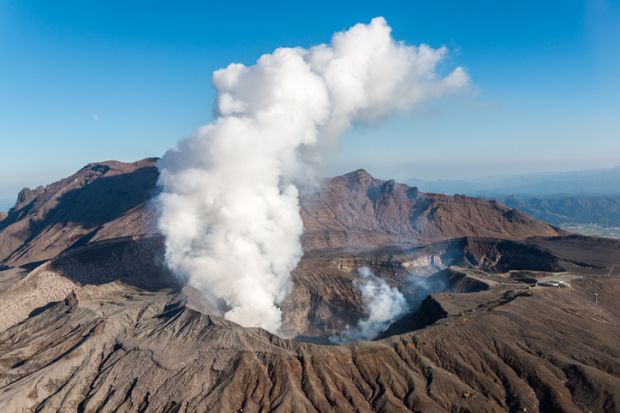A simmering volcano in disaster-weary Japan has unleashed a spout of academic misery, generating multiple misconduct scandals and blowing the lid on a little-recognised arena of research fabrication.
The journal Science has retracted a November 2016 paper which suggested that a series of earthquakes seven months earlier in Kyushu, which killed dozens when they devastated the city of Kumamoto, could have been worse if a magma chamber under Mount Aso had not cushioned the force.
Kyoto University, host institution of five of the six authors, launched a confidential investigation in August 2017 into reported irregularities in the paper. In April this year, the university announced that the probe had uncovered falsifications in four images and instances of plagiarism.
The episode follows nearby Osaka University’s revelation in March this year that one of its former researchers, Yoshiya Hata, had fabricated data in five papers, including four about the Kumamoto earthquakes. The first of the articles was subsequently retracted by the journal Seismological Research Letters.
Osaka said the investigation had reserved judgement on another 17 of Dr Hata’s papers, explaining that the committee had been unable to interview him or examine his raw data because he had died before the inquiry began.
Geophysicist Ross Stein, an adjunct professor at Stanford University, highlighted the consequences for science. “Publications that are subsequently identified as fraudulent mislead both scientists and the public,” he wrote on his earthquake watch site Temblor.
“Even though publication can be fast, self-correction can be slow…as is evident from the 28-month period from publication of these papers to public exposure.”
The Kyoto investigation found that maps in the Science paper had been distorted, geographical features mislocated and data from a University of Tokyo researcher plagiarised and manipulated.
Lead author Aiming Lin reportedly blamed the falsifications on carelessness and said they did not affect the paper’s conclusions. The investigating committee found that the distortions were not random errors caused by the difficulty of conducting field observations in a disaster zone. Rather, they systematically supported the authors’ hypothesis.
While deferring judgement on whether Professor Lin had been deliberately deceptive, the investigators nevertheless branded his actions as fraud. Kyoto has flagged punishment but has not specified what action it will take, with Japan currently observing a 10-day holiday to mark its new emperor’s accession.
The investigation absolved his co-authors. Professor Stein said research fraud in seismology was under-reported and “always hushed” because colleagues wanted to avoid appearing vindictive or incurring legal problems. “There are rumours, retractions and – when things really implode – news articles. But otherwise very little appears above the waterline,” he told Times Higher Education.
“If we as a community talk more about this issue, researchers can foresee these problems and learn what their options are.”
Volcanology is a flagship research area for Kyoto. Its laboratory at Aso, Japan’s biggest active volcano, was damaged in the 2016 earthquakes.
Register to continue
Why register?
- Registration is free and only takes a moment
- Once registered, you can read 3 articles a month
- Sign up for our newsletter
Subscribe
Or subscribe for unlimited access to:
- Unlimited access to news, views, insights & reviews
- Digital editions
- Digital access to THE’s university and college rankings analysis
Already registered or a current subscriber? Login








